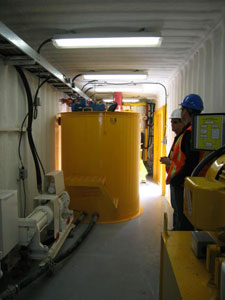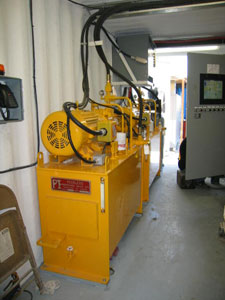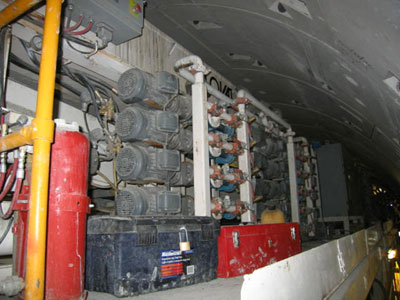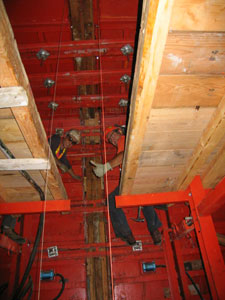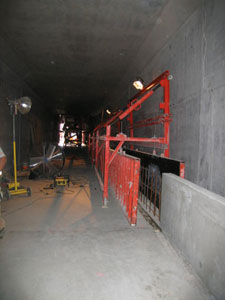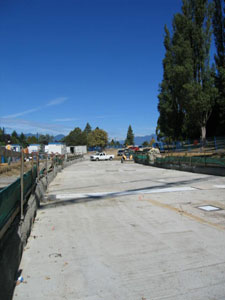Canada Line on track to meet Olympic deadline
Mar 2007
Shani Wallis, Editor
Construction of Vancouver's rapid transit Canada Line between downtown and the city's international airport is a flagship project for hosting the 2010 Winter Olympic Games. Critical to meeting this commitment is the 2.45km of twin TBM tunnel and the underground stations in the heart of the city. TunnelTalk reports on several technical firsts adopted to complete the demanding tunnel job.
-

Canada Line alignment
- The critical path on Vancouver's 19km long Canada Line rapid transit construction program is excavation of the 2.45km long twin bored TBM tunnels through the downtown area. Not only are geological conditions very complex, the logistics are daunting. The TBM is required to work though abrasive sandstone and boulder infested glacial and interglacial till, on steep gradients of up to 5.5%, through tight radius curves of 200m, and within meters of existing underground infrastructure and private property lines.
- To manage the challenge, the tunnel contract is awarded as a design-build undertaking to a joint venture of SNC-Lavalin Constructors Pacific of Canada and tunnel specialists SELI of Italy. Tunnel boring started in June 2006 and broke through into the Vancouver City Center station box on March 1, 2007, just days adrift of the late-February milestone. "With the remaining 500m of this first drive expected to finish by mid-April, we are on schedule and on program, which is a fortunate position after a slow start and tough progress through a stretch of wet interglacial material at the end of last year", said Brendan Henry, Chief Engineer of SNC-Lavalin/SELI JV.
- Together with the city center bored tunnels, the Line and its total 16 stations comprises a 7km length of cut-and-cover connecting sections of elevated and at grade guideway taking the route south over new transit bridges across the Middle and North Arms of the Frazer River to the airport and beyond to Richmond (Fig 1). Civil work on all elements began in late 2005 with the commitment to have the line operating in time for the city's hosting of the 2010 Winter Olympic Games. Since then the race is on to have construction completed and the line opened in early November 2009 ahead of the Opening Ceremony in February 2010.
- By mid-February 2007, at 20 months into the 4 1/2 year procurement, Roger Woodhead, Technical Director for the Line's Engineering, Procurement and Construction Project Office confirmed that work was about 36% complete, adding that; "overall construction is on program and things are looking good".
-

Built within a dense urban setting
-
TBM point of attack
Work by the SNC-Lavalin/SELI JV (SSJV) contract started in November 2005 with excavation of the Olympic Village station box to provide access for the TBM drives. At the same time, the JV contracted with Lovat of Toronto to supply a 6m diameter EPB TBM. Ahead of its arrival, Excavation of the Yaletown and Vancouver City Center station boxes also started to facilitate progress of the TBM drives ahead of architectural and M&E fit-out and finish of the three stations under separate contract. - In the restricted city location, the two mid-city stations presented particular challenges themselves. The 20m wide excavations stretch to within 600mm of high-rise towers and their foundations either side of the streets. In some cases, the walls of underground parking garages were only narrowly set back from or actually border the property lines. To provide a stiff support of the 20m deep excavations the JV elected to install walls of slim micro- and mini-drilled piling within a minimum 600mm clearance of the property lines. In these excavations the JV installed two upper levels of internal bracing and tie back anchors below the basement and foundation structures. The urban setting further complicated station excavation by requiring extensive utility diversions, complex traffic and pedestrian detour and decking, and heavy truck transportation of materials and muck haulage through congested city streets.
-
High-spec TBM design
To match the tunnel excavation challenges, the JV has procured from Lovat one of the most advanced TBM systems used in Canada to date, incorporating features designed specifically to ensure absolute minimum ground settlement through highly variable geology. - Geological conditions range from weak, generally massive (high RQD) sandstone and siltstones of 5 to 10MPa UCS, to dense glacial till of a clay-silt-sand matrix interspersed with granite and granodiorite boulders of up to 2-3m across and more than 250MPa in UCS. The till contains interglacial waterbearing layers of sand and gravel and pockets of coarse saturated running sand while the abrasive sandstone includes cemented sandstone 'floaters' of up to 50MPa UCS and occasional harder volcanic dykes.
- Permeability in the strata is low at about 10-7 in the sandstone/siltstones and 10-8 in the dense glacial tills but the potential of meeting interglacial deposits of saturated sand and silts has required the dual mode rock/mixed face EPB TBM to operate for the most part in the closed pressure balancing mode, using extensive soil conditioning to lower abrasivity, extract more competent material through the screw conveyor and lower full plenum cutterhead torque.
-

Touch screen grounting controlled
- Further weapons in the arsenal to minimize settlement include the first use in Canada of a through-the-tailskin annular grouting system and a two-component grout. The system is designed and manufactured by Team Mixing Technologies of Canada and comprises a batch plant on the surface and separate Part A and Part B injection pumps on the TBM backup. Both the Part A cement, flyash and bentonite mortar and the Part B accelerator is mixed and pumped from the surface to holding tanks on the TBM backup. From there the components are conveyed via six Part A and six Part B peristaltic pumps to six independent tailskin injection lines and ports. Usually only the upper 4 of these ports are used.
- To further combat settlement, annular grouting is linked via plc to the excavation cycle to prevent advance until the grouting system is on-line and ready to fill immediately the void created as the machine moves forward. At shut down for the next ring build cycle, the Part A pumps continue for an extra 30 seconds to prevent clogging of the injection ports.
- In full EPB mode, the machine is designed to operate at up to 4 bar pressure. The Foamex TR soil conditioning system provided by Lamberti generates and injects foam to the plenum via seven independent injection ports. Eight pressure sensors in the system - two in the screw conveyor and six in the plenum - monitor operating pressures and provide real time data to the operating screens in the operator's cabin. There is also a bentonite replacement system to provide fine control of EPB pressure in the plenum and guard against rapid ground loss settlement.
- As the TBM advances, the tunnels are lined with a rings of rebar reinforced precast concrete segments each 250mm thick x 1.4m wide bolted and gasketed ring comprising five segments and a key.
- The segments are produced at a casting yard in Nanaimo on Vancouver Island where the JV supplied three sets of segment moulds from S.A.M.E. of Italy. To match the planned TBM production schedule, segments for nine complete rings must be cast per day. Steam curing helps achieve the minimum 15MPa strength for the five-hour strike needed to achieve the necessary three casts/mould/24h. Segments are stored in the yard until they reach the 40MPa design strength and are transported via truck on ferry to the Olympic Village access site.
-

Vacuum segment erector
- At the TBM, the lining is built using the first known application in Canada of a vacuum segment erector. The machine's tacs acs guidance system forecasts the correct build of the tapered ring and provides accurate steering through the numerous horizontal and vertical curves of the alignment. The bored tunnel construction program is based on completing an excavation cycle in 40 minutes and a ring build in 20 minutes. The TBM is serviced by trains of four muck cars, two segment cars, a flat car and a man carrier pulled by 35 ton Schöma loco. Traction power is shared between the loco and two muck cars to assist haulage up the maximum 5.5% gradients. Long-term disposal of natural non-contaminated muck is barged to sea for controlled ocean disposal.
-

Breakthough of the TBM
- In a paper presented at the TAC conference in Vancouver in September 2006, the authors explained that the TBM supplied by Lovat for the project has an installed torque capacity some 18% higher than recent machines of similar diameter and of 100% higher than similar diameter machines built only eight years ago. "Meeting the demands of this project has pushed EPB system specifications to a higher level than anything used previously in Canada", said Brendan Henry for the JV.
-
TBM delivery and performance
The TBM arrived on site in May 2006 and was assembled in time to start boring by the end of June. "Since then, progress has gone through a roller coaster", said Henry. After launching on a down slope of 2% the alignment dived quickly to 5.5% to clear the foundations of a high rise building the TBM passed immediately into a downward left hand curve under False Creek. "Fortunately we started in good quality sandstone and while the TBM performed well, its delivery was delayed by influences beyond Lovat's control, and the backup system caused us delay through the learning curve, which altogether set us about six weeks behind schedule." On the far side of the Creek, the TBM passed through an interface into the till without any problems but a high concentration of boulders damaged to the grizzle-bars across the cutterhead openings and caused some blockages of the 10m long screw conveyor that extends into the invert of the plenum. In the dense till, repair of the grizzle bars could be carried out in free air but the work did cost time. - The machine then entered another reach of good dense till in which the best advance rates to date were achieved - 19 rings or 27m in a production day, with penetration rates of up to 100mm/min. This however came to an abrupt slow down when the heading entered a zone of saturated sand that lasted about 350m.
-

working site of the bored tunnels
- The saturated sand wasn't a surprise to the team according to Henry, but its persistent length and permeability was. "Pockets of saturated sand in the glacial till of Vancouver are known to exist but we are excavating at a deeper level than anything completed in the city to date and this was not a pocket. It was a long length in which EPB pressures were up to 2.2 bar." In these conditions volumes of water were flowing into the plenum and along the annulus of the shield and causing an out rush of water through the screw at start of every stroke.
- At the time the TBM was heading toward the tight 200m curve from Davie Street into Granville Street and passage under and near the foundations of two 35 storey high towers en-route. In addition, the schedule was nearing the Christmas holiday shut down.
- Given the circumstances, it was decided to halt the machine for the holiday break before going into under the building. Polyurethane grout into the shield annulus was attempted to allow access to the cutting head for tool changes before entering the buildings footprint, but without success.
- Following the holiday break the TBM inched through the curve and back into sandstone for the first opportunity after more than 450m to carry out a man entry inspection in free air. All the17in twin disc cutters and most of the ripper tools were thoroughly worn down and all needed replacing. Abrasivity of the material, particularly of the sandstone, is said to be proving higher than expected with samples testing to some 50% quartz content against the 27-30% anticipated. After driving through the earlier Yaletown station box, breakthrough into the Vancouver City Centre station box provided the first opportunity to inspect the body of the shield and the chromium carbide plate applied to protect the cutterhead face against abrasive wear. First impressions of the cutterhead, prior to cleaning, were that it looked good, according to Henry.
-

A running tunnel bore
- Following the extended maintenance and tool change, progress picked up again to steady rates of 18 rings a day through the sandstone. By mid-February, after completing some 2km of the first 2.45km drive work was almost back on schedule. At the beginning of the drive crews have worked two 10h shift/day with a 4h maintenance program 5 days/week but quickly changed to three 8h shifts, 6 days/week to catch up the schedule with maintenance on Sundays.
- For the most part the TBM has operated in the closed EPB mode under pressures ranging from 0.6 to 2.6 bar at the center of the plenum and settlement readings along the route have been negligible - mostly less than 4mm and a maximum of less than 7mm. According to Henry the ground conditioning and two-part grouting systems have performed quite well. "We do get some clogs of accelerated grout at the ports but replacement of an injection pipe is a quick 20-30 minute job. We are also suspecting some clumping of the grout rather than a uniform annular fill. We have worked with different mix designs and will introduce some refinements for the systems before starting the second drive."
-
Advance program
Breakthrough into the partially excavated Vancouver City Center station box exposed the top of the TBM from about spring line up. As the machine advances it will excavate the remaining bench and will build full rings of lining behind. Building only invert segments was considered but this presented issues of preventing buckling of the invert segments against the forward thrust; requiring some kind of upper thrust ring system; and staying on line and level. Building full rings of segments grouted in the invert with the quick setting two-part grout, will allow the TBM to maintain normal production through the partially excavated box and eliminate the potential for any time loss through the station. - After programmed inspection and maintenance of the machine in the station box, the remaining 500m of the first drive to the TBM reception shaft is expected to hole through by mid April. Once transported back to the Olympic Village site, the second drive is expected to start in 2.5 months and take ten months to complete. The TBM will be pushed through fully excavated boxes at Yaletown and Vancouver City Center on the concrete slabs and is scheduled to reach the reception shaft by about March 2008. The line's end station at Waterfront Center is being completed under a separate contract that includes a 400m link of cut-and-cover to the TBM reception shaft.
- With the first drive behind them, the SSJV team has good knowledge of what awaits them on the second.
-

Rolling program of...
-

cut-and-cover work...
-
Cut-and-cover on a roll
In the meantime, cut-and-cover construction of the 7km section south along Cambie Street from is progressing from five rolling-program fronts between four open cut stations. For the most part, the cut and cover alignment is a side-by-side configuration of 10m wide and between 8-10m deep, with a section of 5m wide, 14m deep double deck configuration between the 23rd and 15th Street junctions. Traffic management around the vital four-lane carriageway must maintain at least one operating lane in each direction and decking to maintain access across intersections at all times. - Excavation is mostly by excavator and hydraulic breakers with a section of drill+blast needed through a zone of volcanic rock for a distance of less than 1km from 29th to 35th Streets. Support of the trench consists of shotcrete and wire mesh and rockbolts in the rock section. Behind the invert base slab, the reinforced walls, center divide and top deck of the box structure are cast as one composite pour using 20m long forms supplied by Peri.
- Each 20m long casting of the 450mm walls and 500mm thick deck consumes some 173m3 of concrete with up to 48 turn-buckles supporting the Peri forms. Cut-and-cover is programmed on one 20m long casting every three days for a total of 40m finished each week.
- The cut-and-cover contract started in early 2006 but fell behind schedule when a month of heavy rainfall retarded progress. To improve the situation the original 14m long Peri forms were extended to 20m, an extra front of rolling program was introduced and the workweek was increased from five to six days to complete two concrete pours/week.
- "Progress through the second half of 2006 was very positive", said Roger Woodhead who added that by mid-February 2007 the cut-and-cover section was set to finish six to eight months ahead of schedule.
- This flexibility of program was said to be one of the principle reasons for proposing a combination of cut-and-cover as well as bored tunnel excavation. "The procurement contract baseline design suggested more bored tunneling excavated with up to three TBMs to meet program", explained Woodhead. "In our winning alternative, we increased the cut-and-cover work to advance as many points of attack as possible to add greater predictability and flexibility, provide for shallower, less expensive, more user-friendly stations and reduce significantly the risk to completing within the tight construction period. The TBM tunnel operation also has the possibility of increasing to a 24h/day, 7 days/week but with no major delays or downtimes it is doing well and we are very pleased with overall progress including on the elevated, at grade and bridge sections."
- Project realization of the Line is a 35-year PPP (public-private partnership) concession awarded to InTransitBC, a limited partnership owned by Canada's giant construction/engineering consortium SNC-Lavalin Inc and two pension fund financial investors. Of the Can$2 billion cost, private equity is contributing $750 million with the public funds from the Federal and Provincial governments and the Airport Authority, and the Cities of Vancouver and Richmond meeting the remainder. To manage construction, InTransitBC awarded an Engineering, Procurement, Construction (EPC) contract to SNC-Lavalin Inc which in turn has awarded various subcontracts to complete the civil, M&E and equipment supply.
-
Canada Line opens ahead of schedule - TunnelCast video, Aug 2009
Canada Line Breakthrough Celebration - TunnelCast video, April 2008


